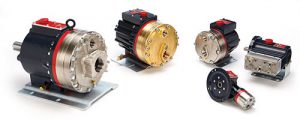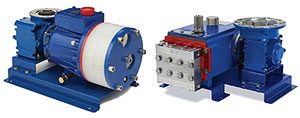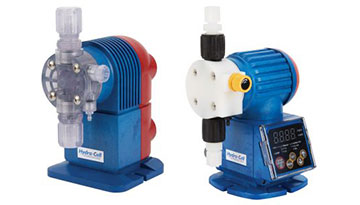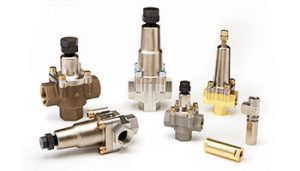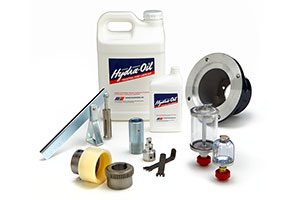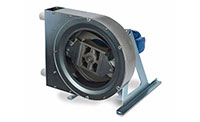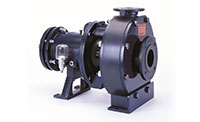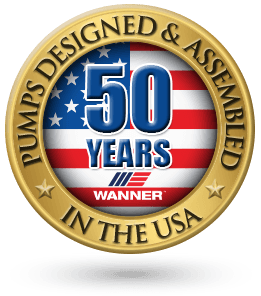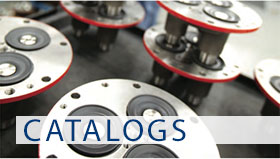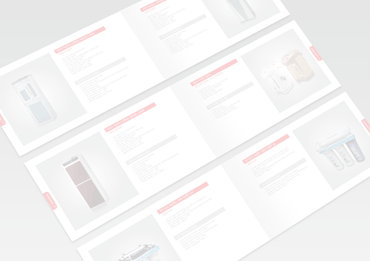FAQ
The pump lubricant in Hydra-Cell pumps performs two functions: (1) it provides flooded oil lubrication to the bearings; (2) it provides hydraulically-balanced displacement to the diaphragms.
Critical to the hydraulic system within each piston, the oil must flow smoothly under high pressures.
Hydra-Oil is available in a variety of standard-duty motor oils, synthetic, EPDM-compatible, and food-grade lubricants to meet these requirements.
Either way.
The smooth, positive displacement delivery of a Hydra-Cell pump can be achieved when rotating the shaft in either direction.
“Nothing”
The unique, seal-less design of Hydra-Cell means that the pump does not require lubrication from the process fluid. In the event of your tank or product source running dry, and air being pulled through the pump, no damage will occur. As fluid again is available, the Hydra-Cell pump will resume pumping.
Up to 800 microns depending on pump model.
Round particles up to 200 microns can pass through Hydra-Cell models F20, M03, D03, and D04. 500-micron particles can pass through models D10, D12, and D15/D17. 800-micron particles can pass through the H25 and D35 model pumps. Critical to the successful pumping of particulates is ensuring that all particles are fully suspended in the fluid to avoid any settling of the solids. Key factors include fluid velocity (pump speed) and particle mass.With intermittent duty, care must be taken to avoid excessive settling in the inlet and discharge plumbing.
The positive displacement performance of the Hydra-Cell pump requires that each application has a pressure regulating valve in the discharge line to allow fluid to divert in the event that excessive pressure builds in the system. Hydra-Cell C Series valves provide this protection for your high-pressure system.
Indefinitely.
When installed properly and no adverse stresses are applied to our elastomeric diaphragms (e.g. excessive vacuum, foreign matter, etc.) the hydraulically-balanced diaphragm will not be a wear component. Due to their poor elastomeric memory, PTFE diaphragms will eventually wear. Maximum life can be achieved with reduced stroke cams and/or by limiting pump speed.
Yes.
Hydra-Cell pumps are engineered to be easy and inexpensive to service.With regular oil changes, most wear is restricted to the check valve components in the fluid end pump head.All wear items are available in repair kits that include service and parts manuals to allow for fast and easy repairs in the field. All repair manuals are available on our website (www.Hydra- Cell.com). Online videos are also available – contact us for details.
A continuous-duty cycle is typically defined as a pump running more than 8 hours per day, 5-to-7 days a week. Continuous applications running at or near maximum pressure may benefit and achieve a longer pump life by sizing the application with the next larger pump model.
Running a pump for shorter periods (intermittent-duty cycle) than a continuous-duty cycle under high temperatures or heavy loads may also affect pump duty selection. In addition, for excessive heat applications (greater than 180 ̊F/82C ̊) using an oil cooler is recommended.
Hydra-Cell pumps use positive displacement performance to produce a steady, dependable flow at pressures from 50 to 2500 psi (3.4 to 172 bar).The output of the pump is entirely dependent on the shaft rpm. Once the required flow rate is known, there are many ways to drive the pump. Shaft coupling directly to a motor with a motor adapter is the most popular drive arrangement.
All our pump models utilize different output crankshafts or cams to produce different flow rates at common electric motor speeds (e.g., 1150, 1450, 1750 rpm with 60 Hz power, etc.). In addition, pumps and motors can be mounted side-by-side and pulley driven with V-belts or cog style belts (see calculating pulley size formulation on page 144). Other drive configurations include hydraulic motors, air motors, gas engines, PTO or any other means to drive the shaft.

